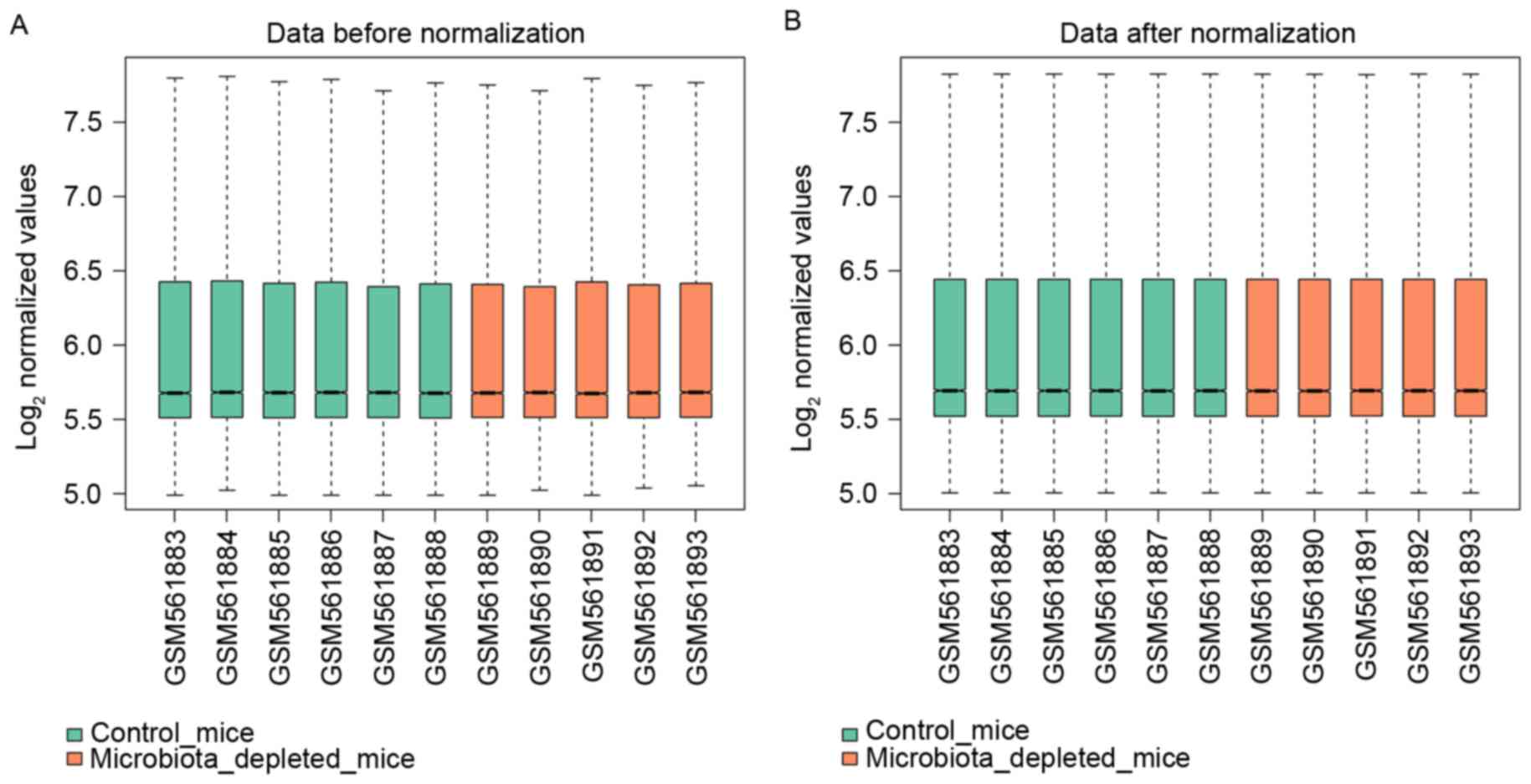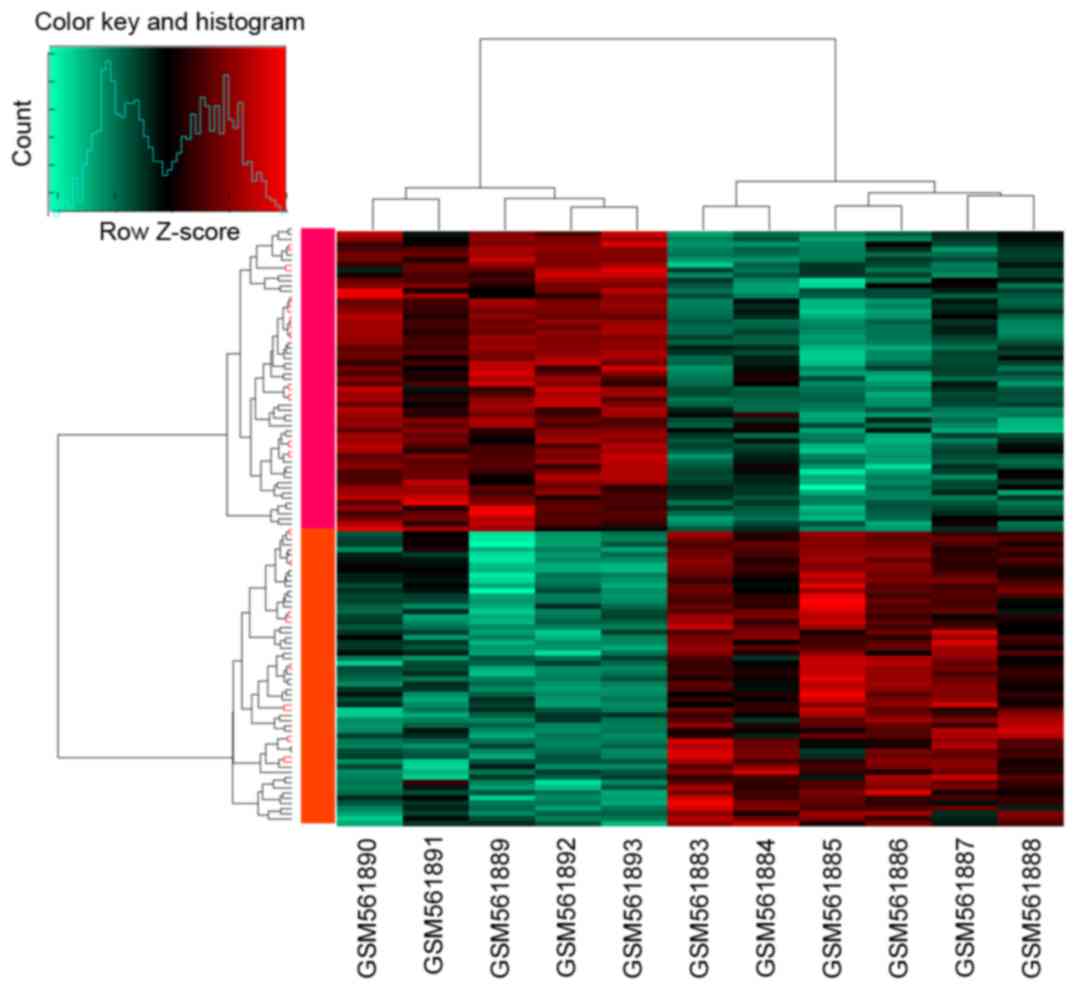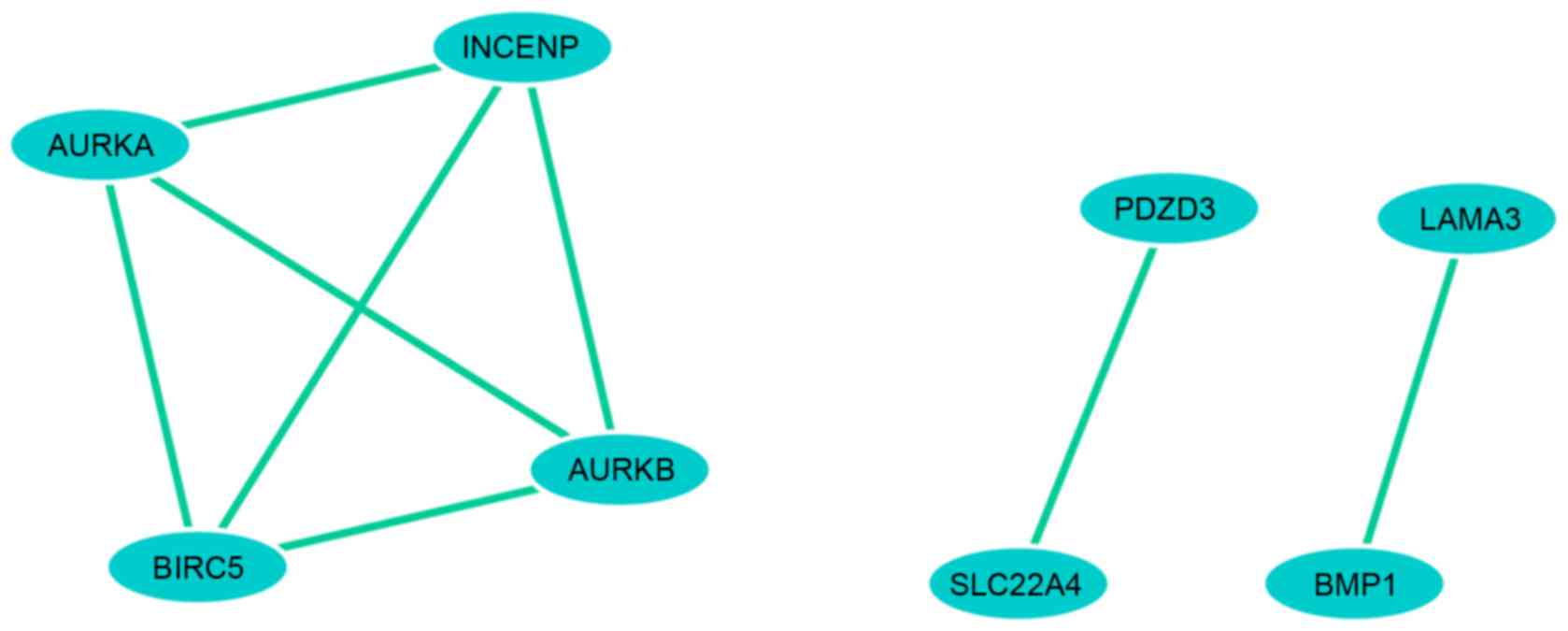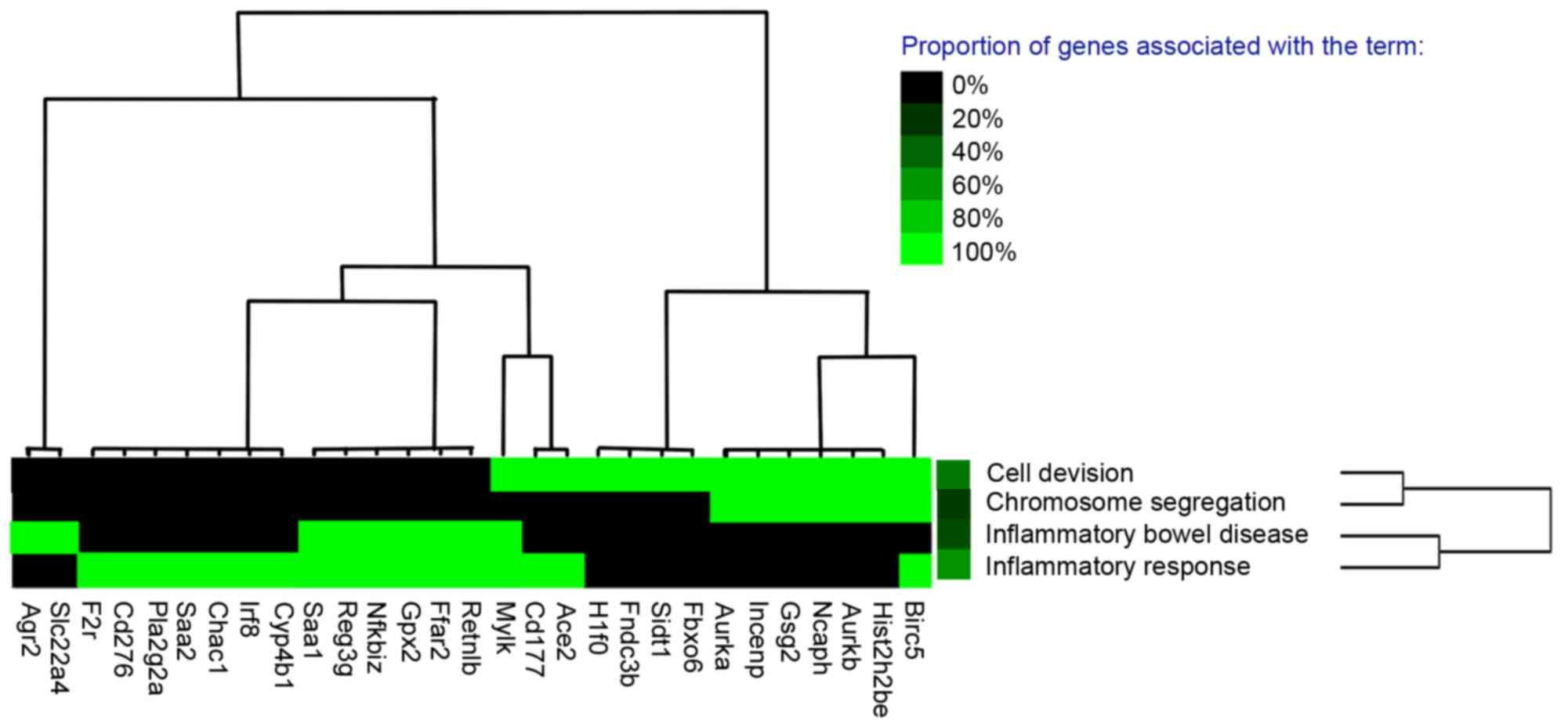Gene expression profiling of the mouse gut: Effect of intestinal flora on intestinal health
- Authors:
- Published online on: December 18, 2017 https://doi.org/10.3892/mmr.2017.8298
- Pages: 3667-3673
-
Copyright: © Zhu et al. This is an open access article distributed under the terms of Creative Commons Attribution License.
Abstract
Introduction
With improvements in living standards, increasing attention is focused on intestinal health. Intestinal health is defined as a state, in which there are no signs of gut disease, no risk of intestinal disease and no intestinal diseases (1). The adhesion of intestinal flora to the intestinal wall can have a beneficial or deleterious role in hosts, and determines the health status of the gut (2). Therefore, investigations of intestinal flora are essential for intestinal health. A previous study showed that the diversity of the colonic mucosa was closely associated with bacterial microflora in patients with active inflammatory bowel disease (3). Disturbances of microbiota may also induce immune dysregulation and can develop into inflammatory bowel disease (4). In addition, gut bacteria can degrade various xenobiotics, including halogenated aromatic compounds, which may be beneficial for human health (5).
Various genes associated with intestinal flora have been identified for investigating intestinal health. In the microbial community, the diversity of genes can provide several types of enzymes and pathways associated with intestinal health (6). Jia et al (7) suggested that cytochrome P450, family 4, subfamily F, polypeptide 14 and tachykinin, precursor 1 interact with each other and are involved in pathways, including the neuropeptide signaling pathway, oxidation reduction and metabolism by regulating intestinal microbiota depletion. In addition, FBJ murine osteosarcoma viral oncogene homolog has been confirmed to enhance gut health by altering the ecology of the gut microbiota and improving the proteolysis of feces (8). Another important gene, interleukin 6 has been confirmed as a key molecule in gut barrier dysfunction (9). Although several genes associated with intestinal health have been investigated, further information is required. Therefore, molecular mechanisms, including critical genes, pathways and their interactions, require investigation.
In the present study, microarray analysis was performed for the screening of differentially expressed genes (DEGs) between microbiota-depleted mice and control mice. Subsequently, functional and pathway enrichment analyses of the DEGs were processed. Finally, literature associated with the DEGs was mined and their associations were analyzed. The results of the present study may identify potential important genes for further investigations on intestinal flora and human health.
Materials and methods
Data acquisition
The gene expression profiles of GSE22648 were downloaded from the Gene Expression Omnibus database (www.ncbi.nlm.nih.gov/geo) with the platform GPL6887 (Illumina MouseWG-6 v2.0 expression beadchip) (10). A total of 11 colon intestinal epithelial cell samples were obtained from mice, including five microbiota-depleted mice and six control mice, and analyzed.
Data preprocessing and DEG screening
The Series Matrix File (ftp.ncbi.nlm.nih.gov/geo/series/GSE22nnn/GSE22648/matrix) was downloaded to transfer probe names into gene symbols based on the platform annotation information. Using the aggregate function of the R statistical package, version 3.4.0 (stat.ethz.ch/R-manual/R-devel/library/stats/html/aggregate.html), the mean value was considered to be the expression value of a gene when multiple probes mapped to a single gene. For probes with missing values, nearest neighbor averaging (11) in the impure package (12) of R was used for offset of the margin value (k value was defaulted to 10). Quantile normalization was applied for standardization based on the preprocessCore package of R. The standard matrix was then obtained.
The DEGs between two groups were screened using the Limma package (13) (bioconductor.org/packages/release/bioc/html/limma.html; version 3.5) and the differences of mean expression values were assessed using the unpaired t-test method. In addition, the Benjamini-Hochberg algorithm (14) was used for p-value correction. Finally, the thresholds of the DEGs were log2 fold change |log2FC| >0.585 and adjusted p-value of P<0.05.
Functional and pathway enrichment of DEGs
The online tool of the Database of Annotation, Visualization and Integrated Discover (DAVID) (15) was used for Gene Ontology (GO; www.geneontology.org) and Kyoto Encyclopedia of Genes and Genomes (KEGG; www.genome.jp/kegg) pathway enrichment analysis of DEGs. The cut-off criterion was P<0.05.
Mining of DEG-associated literature
The DEG-associated literature was mined using the GenCLip 2.0 online tool (ci.smu.edu.cn) (16). The Gene Cluster with Literature Profiles module generated statistically overrepresented key words grouped by a fuzzy cluster algorithm to annotate the input genes. The key words were generated based on the occurrence frequencies of free terms in the gene-associated literature or were provided by the user. The associations among the genes and keywords were linked to the relevant MEDLINE abstracts in which the co-occurrence of genes and keywords are highlighted. The Literature Mining Gene Networks module was used to construct a gene-network of the input genes and generate sub-networks based on the user defined query terms. It also calculated the probability of the random occurrence of the networks through random simulation, and provided GO and pathway enrichment analyses of genes. Co-citation networks of DEGs were constructed for the mining of ‘hot genes’ which were observed to be repeatedly associated with the other genes. At the same time, the DEGs were clustered to mine the functional information of key genes in previous studies with thresholds of P<0.0001 and hit ≥4.
Results
Data preprocessing and DEG screening
Following data preprocessing, a total of 30,865 expression data of transcripts were obtained from 11 samples. As shown in Fig. 1, the median of each sample was at the same level.
A total of 115 DEGs were screened with the thresholds of |log2FC| >0.585 and adjusted p-value of P<0.05, which included 58 upregulated genes and 57 downregulated genes. The cluster heatmap of the DEGs is shown in Fig. 2.
GO functional and KEGG pathway enrichment analysis
As shown in Table I, the screened upregulated genes were significantly enriched into various GO terms, including microsome, oxidation reduction and heme binding. They were also enriched in the pathway of drug metabolism. The 57 downregulated DEGs were enriched in different functions, including DNA packaging, nucleosome assembly and nucleosome. These downregulated DEGs were also enriched in pathways, including arachidonic acid metabolism, systemic lupus erythematosus and linoleic acid metabolism.
DEG-associated literature mining
By mining the citation associations between the DEGs in PubMed, at least eight genes were found to have pairwise co-citation associations. In addition, four upregulated DEGs and four downregulated DEGs were identified with high co-citation levels (Fig. 3 and Table II). Therefore, four downregulated DEGs, including baculoviral IAP repeat containing 5 (BIRC5), aurora kinase A (AURKA), aurora kinase B (AURKB) and inner centromere protein antigens 135/155 kDa (INCENP) were co-cited in several studies. The four upregulated genes were laminin α3, bone morphogenetic protein 1, solute carrier family 22 (organic cation/zwitterion transporter), member 4 (SLC22A4) and PDZ domain containing 3.
Gene cluster analysis with the literature profiles of all DEGs was processed (Fig. 4 and Table III). The results showed that a total of 19 genes, including BIRC5, AURKB, angiotensin I converting enzyme 2 and free fatty acid receptor 2, were enriched in four modules, including cell division, chromosome segregation, inflammatory bowel disease and inflammatory response. In addition, these modules were associated with various functional terms, including inflammatory response, chromosome condensation, chromosomal passenger complex and phospholipase A2.
Discussion
Gut bacteria and their reactions are important in gut health and general human health (17). Understanding the process and potential mechanism of the effect of microbial intestinal metabolism on human health is important for the treatment of intestinal diseases (18). In the present study, four upregulated DEGs and four downregulated DEGs were identified with high co-citation levels. Among these genes, the AURKA, INCENP, BIRC5 and AURKB downregulated genes and SLC22A4 upregulated gene were important DEGs, which were enriched in four modules, including cell division, chromosome segregation, inflammatory bowel disease and inflammatory response.
A previous study indicated that intestinal cell proliferation is associated with epithelial homeostasis, regeneration (19), and various diseases, including obstructive jaundice (20) and cancer (4). In the present study, AURKA was identified with a high number of citations on literature mining. This gene encodes a protein, which is a cell cycle regulated kinase, and is also closely associated with chromosome segregation (21). Ratushny et al (22) suggested that by combining with AURKA, SRC kinase was activated and further affected various biological processes, including tumor invasion. In addition, AURKA locates at the spindle poles and regulates cytokinesis by regulating centrosome maturation (23). In the colon of HNF4α mutant mice, the expression of AURKA was significantly upregulated, and HNF4α was a key regulator for ion transport in the gut mucosa. Therefore, the findings of the present study suggested that AURKA may be involved in the functional modules of chromosome segregation and cell division, and may be important in affecting intestinal microbiome homeostasis in intestinal health.
AURKA is concentrated primarily at the spindle poles in the period of meiosis (MI) and meiosis II, whereas AURKB locates at kinetochores in the period of MI (24). As with AURKA, AURKB was identified in the present study as being enriched in functions of chromosome segregation and cell division. Fenton et al (25) processed a microarray analysis, and showed that leptin may upregulate the expression of AURKB and further induce colon epithelial cell proliferation. In addition, the expression of AURKB can be regulated by microRNA (miR)-24 by recognizing complementary sequences (26). In addition, in irritable bowel syndrome, miR-24 has been confirmed to increase gut permeability (27). Therefore, AURKB may also be a target in the treatment of intestinal disease.
INCENP is a complex partner of AURKB for kinase activation, and the regulation of chromosome segregation and cytokinesis (28). In the present study, INCENP was screened to have a high number of citations, and was enriched in cell division and chromosome segregation. INCENP has also been confirmed to be an important member of the chromosomal passenger complex, which is an essential regulator for the completion of cell division (29). In addition, INCENP/Sli15 phosphorylation can activate Aurora B/IpI1, which is important for the activity of the chromosomal passenger complex (30). The expression of INCENP has also been shown to be increased in several types of cancer, including colorectal cancer (31). Therefore, the present study hypothesized that INCENP may affect intestinal health through interacting with AURKB.
In the present study, BIRC5 was enriched in three modules, including cell division, chromosome segregation and inflammatory response. Neufert et al (32) confirmed that BIRC5 can limit bacterial growth and is involved in mucosal wound healing, which suggests a promising therapeutic approach for disturbed intestinal homeostasis. In addition, activated signal transducer and activator of transcription 3 can induce the transcription of BIRC5 and regulate tissue defense during the process of gastrointestinal infection. Previous studies have also shown that microbiota and commensal bacteria can induce inflammatory response in immunocompromised hosts (33), and when the normal microbial community is disrupted, the risk of inflammation is increased (34), This offers novel insights into the pathogenesis of disease for treating intestinal disorders. The gut microbiota can also affect host metabolism and produce various pro-inflammatory molecules, including lipopolysaccharide, assisting in the development of treatments for metabolic diseases (35). Therefore, BIRC5 may be a critical gene in the effects of microbiota on intestinal health.
Of the upregulated DEGs identified in the present study, SLC22A4 was found to have a high number of citations and was enriched in the module of inflammatory bowel disease. A mutation of SLC22A4, which encodes organic carnitine transporter 1, has been confirmed to have a clinical role in gut health (36). In addition, Tokuhiro et al (37) showed that the organic cation transporter SLC22A4 functioned as a transporter in the inflammatory milieu. A previous study also confirmed that polymorphisms of SLC22A4 were closely associated with early inflammatory bowel disease (38). The development of the gut microbiota is essential for promoting the gut immune system and maintaining system balance (39). Therefore, SLC22A4 may be an essential gene for intestinal health via modulating the immune system.
In conclusion, the present study performed bioinformatics analysis of the effects of gut flora on molecular changes in intestinal epithelial cells. AURKA, INCENP, BIRC5, AURKB and SLC22A4 were identified as potential target genes for intestinal disease treatment through their involvement in various functions, including cell division, chromosome segregation, inflammatory bowel disease and inflammatory response. These results indicate novel therapeutic targets for diseases caused by disturbed intestinal homeostasis. However, there were limitations to the present study; gut microbiota are associated with the delivery mode and the type of feeding in infants, and changes throughout life between infancy and elderly. Therefore, further experiments are required to confirm the results obtained in the present study.
References
|
Abreu MT, Fukata M and Arditi M: TLR signaling in the gut in health and disease. J Immunol. 174:4453–4460. 2005. View Article : Google Scholar : PubMed/NCBI | |
|
Jeurissen SH, Lewis F, van der Klis JD, Mroz Z, Rebel JM and Ter Huurne AA: Parameters and techniques to determine intestinal health of poultry as constituted by immunity, integrity and functionality. Curr Issues Intest Microbiol. 3:1–14. 2002.PubMed/NCBI | |
|
Ott SJ, Musfeldt M, Wenderoth DF, Hampe J, Brant O, Fölsch UR, Timmis KN and Schreiber S: Reduction in diversity of the colonic mucosa associated bacterial microflora in patients with active inflammatory bowel disease. Gut. 53:685–693. 2004. View Article : Google Scholar : PubMed/NCBI | |
|
Round JL and Mazmanian SK: The gut microbiota shapes intestinal immune responses during health and disease. Nat Rev Immunol. 9:313–323. 2009. View Article : Google Scholar : PubMed/NCBI | |
|
Qin J, Li R, Raes J, Arumugam M, Burgdorf KS, Manichanh C, Nielsen T, Pons N, Levenez F, Yamada T, et al: A human gut microbial gene catalogue established by metagenomic sequencing. Nature. 464:59–65. 2010. View Article : Google Scholar : PubMed/NCBI | |
|
Guarner F and Malagelada JR: Gut flora in health and disease. Lancet. 361:512–519. 2003. View Article : Google Scholar : PubMed/NCBI | |
|
Jia ZY, Xia Y, Tong D, Yao J, Chen HQ and Yang J: Module-based functional pathway enrichment analysis of a protein-protein interaction network to study the effects of intestinal microbiota depletion in mice. Mol Med Rep. 9:2205–2212. 2014. View Article : Google Scholar : PubMed/NCBI | |
|
Smith AG, O'Doherty JV, Reilly P, Ryan MT, Bahar B and Sweeney T: The effects of laminarin derived from Laminaria digitata on measurements of gut health: Selected bacterial populations, intestinal fermentation, mucin gene expression and cytokine gene expression in the pig. Br J Nutr. 105:669–677. 2011. View Article : Google Scholar : PubMed/NCBI | |
|
Song M and Kellum JA: Interleukin-6. Crit Care Med. 33 12 Suppl:S463–S465. 2005. View Article : Google Scholar : PubMed/NCBI | |
|
Reikvam DH, Erofeev A, Sandvik A, Grcic V, Jahnsen FL, Gaustad P, McCoy KD, Macpherson AJ, Meza-Zepeda LA and Johansen FE: Depletion of murine intestinal microbiota: Effects on gut mucosa and epithelial gene expression. PLoS One. 6:e179962011. View Article : Google Scholar : PubMed/NCBI | |
|
Altman NS: An introduction to kernel and nearest-neighbor nonparametric regression. The American Statistician. 46:175–185. 1992. View Article : Google Scholar | |
|
Hastie T, Tibshirani R, Narasimhan B and Gilbert C: Impute: Imputation for microarray data. Bioinformatics. 17:520–525. 2001.PubMed/NCBI | |
|
Shabalin AA, Tjelmeland H, Fan C, Perou CM and Nobel AB: Merging two gene-expression studies via cross-platform normalization. Bioinformatics. 24:1154–1160. 2008. View Article : Google Scholar : PubMed/NCBI | |
|
Rudy J and Valafar F: Empirical comparison of cross-platform normalization methods for gene expression data. BMC Bioinformatics. 12:4672011. View Article : Google Scholar : PubMed/NCBI | |
|
Leek JT, Johnson WE, Parker HS, Fertig EJ, Jaffe AE, Zhang Y, Torres LC and Storey JD: sva: Surrogate Variable Analysis. R package version 3. 2013. | |
|
Wang JH, Zhao LF, Lin P, Su XR, Chen SJ, Huang LQ, Wang HF, Zhang H, Hu ZF, Yao KT and Huang ZX: GenCLiP 2.0: A web server for functional clustering of genes and construction of molecular networks based on free terms. Bioinformatics. 30:2534–2536. 2014. View Article : Google Scholar : PubMed/NCBI | |
|
Puupponen-Pimiä R, Aura AM, Oksman-Caldentey KM, Myllärinen P, Saarela M, Mattila-Sandholm T and Poutanen K: Development of functional ingredients for gut health. Trends Food Sci Technol. 13:3–11. 2002. View Article : Google Scholar | |
|
Pérez-Cobas AE, Gosalbes MJ, Friedrichs A, Knecht H, Artacho A, Eismann K, Otto W, Rojo D, Bargiela R, von Bergen M, et al: Gut microbiota disturbance during antibiotic therapy: A multi-omic approach. Gut. 62:1591–1601. 2013. View Article : Google Scholar : PubMed/NCBI | |
|
Barker N: Adult intestinal stem cells: Critical drivers of epithelial homeostasis and regeneration. Nat Rev Mol Cell Biol. 15:19–33. 2014. View Article : Google Scholar : PubMed/NCBI | |
|
Assimakopoulos SF, Tsamandas AC, Louvros E, Vagianos CE, Nikolopoulou VN, Thomopoulos KC, Charonis A and Scopa CD: Intestinal epithelial cell proliferation, apoptosis and expression of tight junction proteins in patients with obstructive jaundice. Eur J Clin Invest. 41:117–125. 2011. View Article : Google Scholar : PubMed/NCBI | |
|
Ding J, Swain JE and Smith GD: Aurora kinase-A regulates microtubule organizing center (MTOC) localization, chromosome dynamics, and histone-H3 phosphorylation in mouse oocytes. Mol Reprod Dev. 78:80–90. 2011. View Article : Google Scholar : PubMed/NCBI | |
|
Ratushny V, Pathak HB, Beeharry N, Tikhmyanova N, Xiao F, Li T, Litwin S, Connolly DC, Yen TJ, Weiner LM, et al: Dual inhibition of SRC and Aurora kinases induces postmitotic attachment defects and cell death. Oncogene. 31:1217–1227. 2012. View Article : Google Scholar : PubMed/NCBI | |
|
Nikonova AS, Astsaturov I, Serebriiskii IG, Dunbrack Jr RL and Golemis EA: Aurora A kinase (AURKA) in normal and pathological cell division. Cell Mol Life Sci. 70:661–687. 2013. View Article : Google Scholar : PubMed/NCBI | |
|
Shuda K, Schindler K, Ma J, Schultz RM and Donovan PJ: Aurora kinase B modulates chromosome alignment in mouse oocytes. Mol Reprod Dev. 76:1094–1105. 2009. View Article : Google Scholar : PubMed/NCBI | |
|
Fenton JI, Lavigne JA, Perkins SN, Liu H, Chandramouli GV, Shih JH, Hord NG and Hursting SD: Microarray analysis reveals that leptin induces autocrine/paracrine cascades to promote survival and proliferation of colon epithelial cells in an Apc genotype-dependent fashion. Mol carcinog. 47:9–21. 2008. View Article : Google Scholar : PubMed/NCBI | |
|
Felekkis K, Touvana E, Stefanou C and Deltas C: microRNAs: A newly described class of encoded molecules that play a role in health and disease. Hippokratia. 14:236–240. 2010.PubMed/NCBI | |
|
Vicario M, Martínez C and Santos J: Role of microRNA in IBS with increased gut permeability. Gut. 59:710–712. 2010. View Article : Google Scholar : PubMed/NCBI | |
|
Honda R, Körner R and Nigg EA: Exploring the functional interactions between Aurora B, INCENP, and survivin in mitosis. Mol Biol Cell. 14:3325–3341. 2003. View Article : Google Scholar : PubMed/NCBI | |
|
Guta FF, O'Tooleb P and Walsha MA: MS04 P01 Structural and functional studies of the probiotic organism Lactobacillus salivarius Mario Bumanna, Heinz. Acta Cryst. 63:s1272007. View Article : Google Scholar | |
|
Yang J, Zappacosta F, Annan RS, Nurse K, Tummino PJ, Copeland RA and Lai Z: The catalytic role of INCENP in Aurora B activation and the kinetic mechanism of Aurora B/INCENP. Biochem. J. 417:355–360. 2009. | |
|
Chang JL, Chen TH, Wang CF, Chiang YH, Huang YL, Wong FH, Chou CK and Chen CM: Borealin/Dasra B is a cell cycle-regulated chromosomal passenger protein and its nuclear accumulation is linked to poor prognosis for human gastric cancer. Exp Cell Res. 312:962–973. 2006. View Article : Google Scholar : PubMed/NCBI | |
|
Neufert C, Pickert G, Zheng Y, Wittkopf N, Warntjen M, Nikolaev A, Ouyang W, Neurath MF and Becker C: Activation of epithelial STAT3 regulates intestinal homeostasis. Cell Cycle. 9:652–655. 2010. View Article : Google Scholar : PubMed/NCBI | |
|
Hooper LV, Littman DR and Macpherson AJ: Interactions between the microbiota and the immune system. Science. 336:1268–1273. 2012. View Article : Google Scholar : PubMed/NCBI | |
|
Kamada N, Seo SU, Chen GY and Núñez G: Role of the gut microbiota in immunity and inflammatory disease. Nat Rev Immunol. 13:321–335. 2013. View Article : Google Scholar : PubMed/NCBI | |
|
Tremaroli V and Bäckhed F: Functional interactions between the gut microbiota and host metabolism. Nature. 489:242–249. 2012. View Article : Google Scholar : PubMed/NCBI | |
|
Shekhawat PS, Sonne S, Carter AL, Matern D and Ganapathy V: Enzymes involved in L-carnitine biosynthesis are expressed by small intestinal enterocytes in mice: Implications for gut health. J Crohns Colitis. 7:e197–e205. 2013. View Article : Google Scholar : PubMed/NCBI | |
|
Tokuhiro S, Yamada R, Chang X, Suzuki A, Kochi Y, Sawada T, Suzuki M, Nagasaki M, Ohtsuki M, Ono M, et al: An intronic SNP in a RUNX1 binding site of SLC22A4, encoding an organic cation transporter, is associated with rheumatoid arthritis. Nat Genet. 35:341–348. 2003. View Article : Google Scholar : PubMed/NCBI | |
|
Ferraris A, Torres B, Knafelz D, Barabino A, Lionetti P, de Angelis GL, Iacono G, Papadatou B, D'Amato G, Di Ciommo V, et al: Relationship between CARD15, SLC22A4/5 and DLG5 polymorphisms and early-onset inflammatory bowel diseases: An Italian multicentric study. Inflamm Bowel Dis. 12:355–361. 2006. View Article : Google Scholar : PubMed/NCBI | |
|
Kelly D, King T and Aminov R: Importance of microbial colonization of the gut in early life to the development of immunity. Mutat Res. 622:58–69. 2007. View Article : Google Scholar : PubMed/NCBI |













